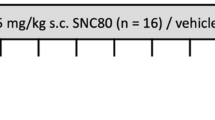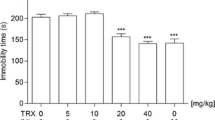Abstract
Locomotor activity and behaviour in the forced swimming test were examined in rats which had received neurotensin (0.5–5.0 µg) in the ventral tegmental area. Doses of 5 µg neurotensin but not lower increased the locomotor activity for at least 2 h. At 0.5 and 1.0 µg neurotensin significantly increased the time the animals spent in struggling with no changes in general motor activity (swimming). The effect of 1.0 µg neurotensin on struggling was completely antagonized by 0.5 µg (−)-sulpiride administered in the posterior nucleus accumbens. The results suggest that activation of the mesolimbic dopamine system through administration of neurotensin in the ventral tegmental area produces antidepressant-like effects. The significance of these findings for a role of endogenous neurotensin in depression remains to be clarified.
Similar content being viewed by others
References
Andrade R, Aghajanian GK (1981) Neurotensin selectively activates dopaminergic neurons of the substantia nigra. Soc Neurosci Abstr 7:184
Armario A, Gavaldà A, Marti O (1988) Forced swimming tests in rats: Effect of desipramine administration and the period of exposure to the test on struggling behavior, swimming, immobility and defecation rate. Eur J Pharmacol 158:207–212
Azzaro AJ, Rutledge CO (1973) Selectivity of release of norepinephrine, dopamine and 5-hydroxytryptamine by amphetamine in various regions of rat brain. Biochem Pharmacol 22:2801–2813
Borsini F, Nowakowska E, Samanin R (1984) Effect of repeated treatment with desipramine in the behavioral “despair” test in rats: antagonism by “atypical” but not “classical” neuroleptics or antiadrenergic drugs. Life Sci 34:1171–1176
Borsini F, Lecci A, Mancinelli A, D'Aranno V, Meli A (1988) Stimulation of dopamine D-2 but not D-1 receptors reduces immobility time of rats in the forced swimming test: implication for antidepressant activity. Eur J Pharmacol 148:301–307
Cador M, Kelley AE, Le Moal M, Stinus L (1985) Behavioral analysis of the effect of neurotensin injected into the ventral mesencephalon on investigatory and spontaneous motor behavior in the rat. Psychopharmacology 85:187–196
Cervo L, Samanin R (1987) Evidence that dopamine mechanisms in the nucleus accumbens are selectively involved in the effect of despiramine in the forced swimming test. Neuropharmacology 26:1469–1472
Cervo L, Samanin R (1988) Repeated treatment with imipramine and amitriptyline reduced the immobility of rats in the swimming test by enhancing dopamine mechanisms in the nucleus accumbens. J Pharm Pharmacol 40:155–156
Cervo L, Samanin R (1991) Effect of chronic treatment with 8-OHDPAT in the forced swimming test requires the integrity of presynaptic serotonergic mechanisms. Psychopharmacology 103:524–528
Cervo L, Grignaschi G, Samanin R (1990) The role of the mesolimbic dopaminergic system in the desipramine effect in the forced swimming test. Eur J Pharmacol 178:129–133
Ervin GN, Birkemo LS, Nemeroff CB, Prange AJ Jr (1981) Neurotensin blocks certain amphetamine-induced behaviours. Nature 291:73–76
Ferris RM, Tang FL, Maxwell RA (1972) A comparison of the capacities of isomers of amphetamine, deoxypipradrol and methylphenidate to inhibit the uptake of tritiated catecholamines into rat cerebral cortex slices, synaptosomal preparations of rat cerebral cortex, hypothalamus and striatum and into adrenergic nerves of rabbit aorta. J Pharmacol Exp Ther 181:407–416
Fibiger HC, Phillips AG (1988) Mesocorticolimbic dopamine systems and reward. Ann NY Acad Sci 537:206–215
Fielding S, Lal H (1978) Behavioral actions of neuroleptics. In: Iversen LL, Iversen SD, Snyder SH (eds) Neuroleptics and schizophrenia (Handbook of psychopharmacology, vol 10). Plenum Press, New York, London, pp 91–128
Glimcher PW, Margolin DH, Giovino AA, Hoebel BG (1984) Neurotensin: a new “reward peptide”. Brain Res 291:119–124
Hökfelt T, Everitt BJ, Theodorsson-Norheim E, Goldstein M (1984) Occurrence of neurotensin-like immunoreactivity in subpopulations of hypothalamic, mesencephalic and medullary catecholamine neurons. J Comp Neurol 222:543–559
Jenner P, Marsden CD (1981) Substituted benzamide drugs as selective neuroleptic agents. Neuropharmacology 20:1285–1293
Kalivas PW, Duffy P (1990) Effect of acute and daily neurotensin and enkephalin treatments on extracellular dopamine in the nucleus accumbens. J Neurosci 10:2940–2949
Kalivas PW, Taylor S (1985) Behavioral and neurochemical effects of daily injection with neurotensin into the ventral tegmental area. Brain Res 358:70–76
Kalivas PW, Burgess SK, Nemeroff CB, Prange AJ Jr (1983) Behavioral and neurochemical effects of neurotensin microinjection into the ventral tegmental area of the rat. Neuroscience 8:495–505
König JFR, Klippel RA (1963) The rat brain. A stereotaxic atlas of the forebrain and lower parts of the brain stem. Williams & Wilkins, Baltimore
Laitinen K, Crawley JN, Mefford IN, De Witte Ph (1990) Neurotensin and cholecystokinin microinjected into the ventral tegmental area modulate microdialysate concentrations of dopamine and metabolites in the posterior nucleus accumbens. Brain Res 523:342–346
Mathysee S (1981) Nucleus accumbens and schizophrenia. In: Chronister RB, DeFrance JF (eds) The neurobiology of the nucleus accumbens. Haer Institute for Electrophysiological Research, Maine pp 315–359
Pinnock RD (1985) Neurotensin depolarizes substantia nigra dopamine neurones. Brain Res 338:151–154
Porsolt RD, Anton G, Blavet N, Jalfre M (1978) Behavioral despair in rats: a new model sensitive to antidepressant treatments. Eur J Pharmacol 47:379–391
Ruggeri M, Ungerstedt U, Agnati LF, Mutt V, Härfstrand A, Fuxe K (1987) Effects of cholecystokinin peptides and neurotensin on dopamine release and metabolism in the rostral and caudal part of the nucleus accumbens using intracerebral dialysis in the anaesthetized rat. Neurochem Int 10:509–520
Seutin V, Massotte L, Dresse A (1989) Electrophysiological effects of neurotensin on dopaminergic neurones of the ventral tegmental area of the rat in vitro. Neuropharmacology 28:949–954
Shi WX, Bunney BS (1987) Neurotensin selectively attenuate dopamine inhibition of midbrain dopaminergic neurons. Soc Neurosci Abstr 13:934
Stevens JR (1973) An anatomy of schizophrenia? Arch Gen Psychiatry 29:177–189
Wise RA (1988) Psychomotor stimulant properties of addictive drugs. Ann NY Acad Sci 537:228–234
Author information
Authors and Affiliations
Rights and permissions
About this article
Cite this article
Cervo, L., Rossi, C., Tatarczynska, E. et al. Antidepressant-like effect of neurotensin administered in the ventral tegmental area in the forced swimming test. Psychopharmacology 109, 369–372 (1992). https://doi.org/10.1007/BF02245885
Received:
Revised:
Issue Date:
DOI: https://doi.org/10.1007/BF02245885




